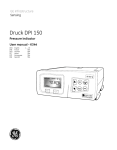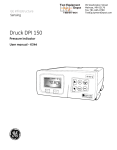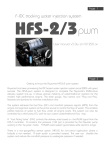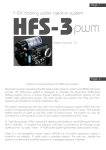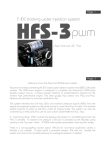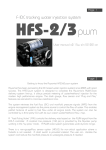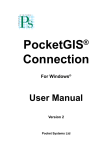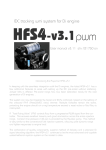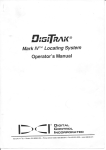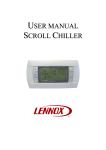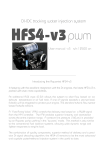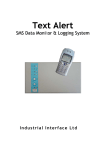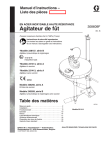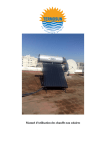Download FIDC tracking water injection system
Transcript
FIDC tracking water injection system User manual v10w GETTING TO KNOW THE AQUAMIST HFS-5 Over the last few years, the demand for great engine power output has increased. The cubic inches option is no longer the norm. Squeezing out 200-300hp per litre is within the reach of the ordinary folks on the street. The tuning industry has grown to embrace new tuning techniques as well as readily affordable components to produce powerful and reliable engines. We at Aquamist have also come to terms with the inevitable, meeting the demands of the market and offering new systems capable of supporting engine powers output up to 1000+ BHP. The HFS-5 reads the duty cycle of a fuel injector and delivers water proportional to fuel flow. Water quantity is metered by a high speed inline valve and flow is monitored by a turbine flow sensor for clogged jet and severed hose detection. A number of options are available for the user to limit engine power in the absence of water flow. We believe the HFS-5 meets all the requirements of a high-end water injection system for achieving fast engine transients and responds with absolute precision. Tracking the fuel delivery is the most reliable method to deliver your fluid flow under the whole engine operating cycle. Anything short of this means having to tailor your fuel map to compensate for the irregular fluid quantity ingested by the engine. Contents: System Check Page 4 5 Checking the contents of the box Getting started on the installation 6 7 8 Installation for long-term reliability Choosing jet size Advanced delivery management 9 Generic wiring diagram Installation Wiring Junction board 10 11-14 Junction board function index Junction board pin-out descriptions 15-16 Gauge function descriptions. 17-18 Setting up the fail-safe 19-21 Customising the system 23 Wiring details Guarantee and Warranty Gauge Fail-safe Advanced Appendix Page 4 Checking the contents of the box carefully This is a “must do” immediately after unpacking .... Water pump Unpack the corrugated sheet carefully. The pump should be labelled with the original custom Shurflo/ Aquamist logo. The white box ♦ ♦ ♦ ♦ ♦ ♦ ♦ ♦ ♦ ♦ 6M of 6mm OD nylon hose (806-261) 2M of 4mm OD nylon hose (806-266) 15A Fused water pump harness with 40A relay 75mm stainless hose clip and support bracket HSV with 6/4 mm hose connector and clips and 2-way sealed plug and socket set (806-244) 0.8 mm water jet (806-323) in plastic bag 0.9 mm water jet (806-324) in plastic bag 1.0 mm water jet (806-325) in plastic bag 1x 4mm Y-piece (806-362) in plastic bag 2x M8 x 1/8 NPT jet adapter with plug (806-357 ♦ 1x water tank adapter 1/8 BSP (806-270) + 6mm qck-fit elbow (806-376) ♦ 100 micron inline water filter (806-257) ♦ 4x M5x 40mm, nuts, washers and fasteners for pump ♦ 1x M6 grounding stud with washed and nuts and 6mm eyelet for pump ground ♦ 5-port brass manifold with 3/8BSP adapter. 3x blanking plugs, 1x 3/8 BSP-M to 1/8BSP-F adaptor 2x 6mm 1/8BSP-M elbow. ♦ 1x 22cc surge arrestor/accumulator (806-409) ♦ 1x Pump label DDS3v10 fluid monitoring system box ♦ ♦ ♦ ♦ ♦ ♦ ♦ Assortment of 22 AWG coloured hook-up wires 1x DDS3 Dash Gauge with 1.5 M x 8-way cable 1x Version 10 Junction box 1x water level switch with connector (806-280c) 1x Digital flow sensor (806-428) A set of wires for inter-connection 3A fuse link with 1.25 inch quick blow fuse Note: Please contact your supplier immediately should you discover any missing parts. Page 5 Getting started on installation Before installation guidelines ♦ The pump and water tank are designed to be fitted in the trunk. Install the water pump and inline filter below the water tank. ♦ Ensure all fittings are tightened and leak proof before filling up with methanol, test it with water first. If high concentration of methanol is used, please vent the tank’s breather hole externally. Methanol is poisonous at high concentrations. ♦ ♦ ♦ ♦ ♦ Assembling the pump in steps Gently assemble the two 3/8 BSP adapters into the pump without crossing the threads. The female one goes into the inlet of the pump. Flow direction is moulded onto the plastic pump head. Ensure o-ring is properly seated. Ensure the accumulator lies horizontally after final tightening. Assemble the accumulator supporting bracket with the metal band supplied. Assemble the rest of the 1/8 BSP elbow fittings and blanking plugs. Ensure all o-ring type fittings are not overly tightened. Mark (dye is smeared on to the bottom of the pump’s rubber feet) and drill four holes for the pump. Water tank components ♦ Ensure the outlet is facing the rear or the side of the tank. Drill/bore a burr-free 7/8“ hole. Clear up all the burred edges and wash the tank thoroughly. No debris or plastic shaving should remain in the delivery system. 1-2 inch from the bottom of the tank is ideal. Don’t over tighten. ♦ Same size hole for the water level sensor. Do not place the sensor near the washer pump, it will not operate properly. The float should swing upwards. The tank venting hole must be re-directed externally if high alcohol concentration is used. ♦ A tall and slim water tank is ideal for this type of application. This minimises delivery surge problems at low water level. 150W pump with 125 PSI Internal bypass valve fitted Voltage: 12VDC Current: 12A max Flow rate: Upto 3.0 LPM max Media: Water and Methanol ERL reference: 8/125/3D0S WARNING: Over 50% Water/Methanol mixture is FLAMMABLE WATER TANK 806-281 806-270 Page 6 Installation for long-term reliability The Junction box: This is the heart of the system and must be installed in a dry location, preferably sited close to the glove compartment. Do not install it in the engine compartment, (It has been done !) Assuming all cables from various locations are routed to the junction box neatly. Please label the flow sensor cable to prevent it from wrongly identified with the 4-core cable from the truck area, Once marked, the cables and wires can be cable tided. The Flow sensor: The location of this sensor is most critical to overall system reliability. It is normally located it in the engine compartment. But there is no reason why it can’t be spliced into any where between the pump outlet and jets/nozzles. The sensor must be installed in a cool area, well away from the a heat source. Bulkhead/fire wall is not a good location as most heat is flowing towards it during motoring. Avoid location near any electromagnetic components such as the ignition coil, solenoid valves and electronic motors. It is very important that the hose is cut cleanly with a razor blade to retain the “roundness”. Side cutter produces a semi-round hose end, major leak will result sooner or later. The hose exiting the fitting must be straight so that the hose is not distorted and will be badly affected in a hot environment. Again, in time it will develop a leak. The most common mistake at this point is cutting the bundled cables very short to improve tidiness. Please don’t. Allow a minimum of 2 feet so that the junction box is accessible when a problem occurs, Longer cable length will not degrade the system performance at all. The Tank level sensor: Avoid locating the sensor tip close to a washer motor. The motor magnet will affect the sensor to read properly. The sensor can be installed 3/4 way down the tank, Preferably at the rear facing wall of the tank. A 23mm burr-free hole must be used to ensure good seal. Never over tighten or the seal will split, just tight enough to prevent leakage, no more. This is the most important section of the DDS3 chapter. Please do not skip reading this part. The 52mm Dash Gauge: Location is not too critical as long as it is in view of the driver. There isn’t too many pitfall on this. Page 7 Choosing jet size Pressure vs Flow This is a general guide only: - 100% water: run 10-15% water/fuel ratio. - 50:50 methanol/water, run 15-20% to fuel. - 100% methanol, run 20-25% to fuel Choosing the jet by calculation: First work out the total fuel flow by adding up the capacity of the fuel injectors. Multiply the result by the preferred % recommended above. 1.0mm Pick the nearest jet/jets size to match the flow. Don’t forget to subtract the boost pressure from the line pressure of 125psi. For example, if you are boosting 25psi, you should select the jet flow at 100 psi. Flow cc/min 0.9mm 0.8mm 0.7mm Once the jet/jets and flow are determined, insert the nearest HSV restrictor to regulate the fluid flow so the delivery will be linear to the duty cycle. 0.6mm 0.5mm 60 70 80 90 100 Pressure (psi) 110 120 125 130 60 46 141 176 211 247 282 317 352 65 48 147 183 220 257 283 330 367 70 50 152 190 228 266 305 343 381 75 52 158 197 236 276 315 355 394 80 54 163 203 244 285 326 366 407 85 55 168 210 252 294 336 378 419 90 57 173 216 259 302 345 388 432 95 58 177 222 266 310 355 399 443 100 60 182 228 273 319 354 410 455 105 61 186 233 280 326 373 420 466 110 63 191 239 286 334 382 429 477 115 120 125 130 PSI 64 66 67 68 195 199 203 208 244 249 254 259 293 299 305 311 342 349 355 365 390 399 407 415 439 449 458 467 488 498 509 519 CC per minute 0.4mm 0.3 0.4 0.5 0.6 0.7 0.8 0.9 1.0 Page 8 Advanced delivery management The HFS-5 is supplied with a set of high-flow water jets, sized at 0.8, 0.9 and 1.0mm (see chart for flow rate). A Y-piece is supplied with the kit for twin jet applications. There are two nickel plated brass jet adapters. Three preHSV in-hose restrictors are supplied for duty cycle/flow matching, should good linearity be required. restrictor HSV clips HSV Please note the HSV should not be installed in areas where there heat and vibration is present. At any point of priming sequence, especially if no fluid is flowing pass it. Do not allow the HSV to be energised for 30 second at a time. The HSV’s wetted parts are designed to work with “99.9% pure” methanol or ethanol only. Avoid using alcohol with unknown denaturant. Always buy alcohol in seal containers or risk cross-contamination during dispensing. Applications involving methanol mix beyond 50%: Great care and attention must be taken to ensure the fluid tank is capable of handling methanol and is designed for this type of application. These tanks are normally termed as a Fuel cell and are available from most reputable racing parts suppliers. Anti-surge foam should be used for circuit racing. Follow the maker’s guidelines carefully. The breather hole must be vented externally with a suitable hose. All fluid delivery hoses and fittings must be free of all leaks. Ensure the area is well ventilated and isolated from the driver’s compartment. Take whatever measures to avoid any methanol fumes building up in trunk area. Methanol is highly flammable. The main delivery hose to the engine bay should be routed underneath the car. Ensure it is securely clipped and fastened. Avoid kinks, close proximity of moving parts and heat producing components. Please treat this recommendation seriously. If in doubt, ask advice from a professional person familiar with this kind of application. DO NOT take any undue risks. It is recommended that a suitable fire extinguisher is placed within easy reach of the driver. All electrical connections must be properly tightened to avoid spark production. Page 9 GENERIC WIRING DIAGRAM FOR HFS-5 with DDS3v10 Aquamist 200 300 TO HSV 400 ml/m for HFS-5 use only FLOW W. INJECTION WATER LEVEL SC WL WH 2 Made in ng land E 3 EXT. DUMMY R OPTIONAL FAIL-SAFE OUTPUT OPTIONS FOR INTERFACING TO ECU OR BOOST CONTROL VALVE DETAILS CAN BE FOUND IN THIS USER MANUAL DDS3v10 JUNCTION BOARD THIS BOARD CAN ONLY BE USED ON ONE MODEL 1 4 OK= 5V +12V 5 6 GND-SW FAULT WIPER CLEAR 7 8 9 10 4-WAY/22AWG INSTALL IN E. BAY INSTALL CABLE (2M) IN E. BAY HSV + HSV XDR + XDR MAP SW BCV + BCV M-SW-0 M-SW-1 M-SW-2 +12V WFS 0V WFS 806-244 Part No. 806-428 Flow range: 100-450ml/min Output range: 0.5-4.5VDC 13 Serial No: 22100 Made by ERL Ltd. Sussex England 14 15 16 PWM IN MPS IN DIMMING FUEL INJECTOR MPS (0-5V) 17 18 19 3A FUSE 20 +12v TO DIM +12V SWITCHED ENGINE ELECTRICAL & ELECTRONICS MANAGEMENT SYSTEM 21 P.RELAY+ P. RELAY+12V IN +0V IN 22 23 24 25 BLK GND DIM-ADJ MAP SWITCH RELAY 12v 1A MAXIMUM 87 85 SYS ON XDR IDR 806-428 FLOW SENSOR 806-075 100 INSTALL THESE PARTS IN TRUNK 6M OF 12AWG CABLE 86 40A RELAY 806-276 39R 30 150W pump with 125 PSI Internal bypass valve fitted Voltage: 12VDC Current: 12A max Flow rate: Upto 3.0 LPM max Media: Water and Methanol ERL reference: 8/125/3D0S WARNING: Over 50% Water/Methanol mixture is FLAMMABLE 806-409 WATER TANK IN TRUNK 12V BATTERY 806-281 806-270 2/10/08 HFS-5 GENERIC.CDR Page 10 DDS3v10 pinout function directory This label defines the unit is preset for a unique WAI system 1 2 3 4 5 6 8 9 +12V WFS 0V WFS 13 14 15 16 PWM IN MPS IN DIMMING 17 18 19 20 21 22 23 24 25 HSV + HSV XDR + XDR MAP SW BCV + BCV M-SW-0 M-SW-1 M-SW-2 1 2 3 4 5 6 7 8 9 10 P.RELAY+ P. RELAY+12V IN +0V IN DIM-ADJ MAP SWITCH RELAY 12v 1A MAXIMUM 7 DDS3-v10 SYS ON XDR IDR 10 16 DUMMY LOAD 17 18 11 12 13 14 15 1, RJ-45 socket for dash gauge (p.11) 2. Inline flow control valve (p.11) 3. External Anti-CEL dummy load resistor (p.11) 4. MAP switching signal output (p.11) 5. Boost Control valve output (p.11) 6. Voltage free relay outputs (p.11) 7. Led brightness for night driving (p.12) 8. System trigger point adjustment (p.12) 9. LED (green) to monitor IDC (p.12) 10. Selecting external dummy resistor (p.12) 11. 4-core cable to turbine flow sensor (p.13) 12. System trigger signal input (p.13) 13. +12V input to enable led dimming (p.13) 14. Tank level/pump control output (p.13) 15. Main power input (fused), IGN.SW#2 (p.13) 16. Internal Anti-CEL dummy resistor (p.13) 17. LED (red) to show system activation (p.14) 18. User selectable system configuration (p.14) Page 11 DDS3 junction board pinout descriptions 1. RJ-45 socket for dash gauge: The DDS3v10 uses a RJ45 connector to link up with the Dash gauge, 2. Inline flow control valve: This output can be used to switch an inline solenoid valve to control flow. Output current is limited to 1 Amp. It is activated by the signal applied to the PWM (pin17) or MAP (pin18) input. User can set the triggering point by using the “Tripadj” potentiometer near the bottom of the junction board. 3. External Anti-CEL dummy load resistor: A more powerful anti-CEL dummy resistor can be connected to this output when excessive heat is produced by the on-board dummy resistor. This option only applies if pin 9-10 is used for cutting the PWM signal to a boost control solenoid valve in the event of failsafe or prolonged “gauge-off period”. 4. MAP switching signal output: Fail-safe output for map switching usage. This output is about 5V and switch to 0v upon fail-safe activation. The signal is short circuit proof with a current limit of 5mA. If an alternative or an inverted output signal is required. this output pin can be reprogrammed via a set of soldering pad on the underside of the circuit board. Please go to page 15, section C/D for a more detailed description of how this can be done. 5. Fail-safe window output (SW GND) When flow signal falls inside the fail-safe window, pin7 will switch to ground immediately. This output can be used to activate a solenoid valve to increase boost pressure. This output can also be used to switch MAP (GND active) on an ECU. 6. Voltage free relay outputs There are three terminals representing a set of voltage-free “change-over” contacts from a relay if anti-CEL -dummy resistor jumper link is un-used. (p10.6). M-SW1 is the “wiper” or “common” pin. M-SW1 and M-SW-0 contacts are opened normally until fail-safe is triggered or gauge is switched off M-SW1 and M-SW-3 contacts are closed normally until fail-safe is triggered or gauge is switched off. Page 12 DDS3 junction board pinout descriptions cont. 7. Led brightness for night driving (p.9) When pin 19 is linked to the headlamp switch, this potentiometer enables user to adjust the brightness level of the gauge leds. 8. System trigger point adjustment (p.9) This potentiometer sets the triggering point of the injection system. In PWM mode, the figure on the left indicates the IDC trip point in 6% steps. Most common onset point is 42%, (12 o’clock). In MPS mode, the figure on the left will help to identify the trip point of a 12 to 72% Manifold Pressure Sensor. To translate the signal % to PSI, please see the table below: 36% 42% 48% 32% 54% 24% 60% 12% 66% 12% 36% PWM MODE 42% 72% 48% 32% 54% 24% 60% 12% 66% 12% MPS MODE 72% .Trip-adj 12 18 24 30 36 42 48 54 60 66 72 2-bar 3-bar % -11 -9.3 -7.6 -5.8 -4.1 -2.3 -0.6 1.2 2.9 4.6 5.6 PSI -9.3 -6.7 -4.1 -1.5 1.7 3.8 6.4 9.0 11.6 14.2 16.8 PSI MAP sensor conversion table: from % to PSI (shaded = vacuum) 9. LED (green) to monitor IDC This led will active when a PWM signal is successfully detected on pin17. It should pulse in unison with the frequency and grows brighter as the duty cyle % increases. This led should not be lit before cranking. After the engine has started, it should pulse in time with engine speed, If the DDS3 is used as a fail-safe to a third party WAI system, this led will only pulse when the PWM pump is activated under normal injection events. 10. Selecting external dummy resistor Selecting ext/int dummy resistor. The on-board Anti-CEL resistor is rated for intermittent usage during fail-safe activation. In the event of prolong activation, it will get very warm. To avoid excessive heat build up, it is recommended to use an external dummy resistor for this purpose, The external resistor is not supplied with the kit but it is widely available in electronics store. The resistor should be 39 ohms, 10W-25W in metal body. NOTE: If anti-cel is not necessary, please leave it on the XDR position or remove the link completely. Page 13 DDS3 junction board pinout descriptions cont. 11. 4-core cable to turbine flow sensor Please ensure the stripped wires are twisted without any loose strands before insertion into the terminal block connector. 12. System trigger signal input Choice of two system triggering signal inputs. Selectable by jumper links (page14.18) PWM IN (pin17): It reads and translates any negative going pulses such as fuel injector or PWM based pump speed controller in to a reference signal to trigger the system and fail-safe circuitry. The system is factory set to detect negative PWM signals. Some pump speed controller uses a positive PWM switching driver, you need to re-configure the DDS3 circuit board manually, (p15.F). MPS-IN (pin18): 0-5V input signal for triggering the system instead of PWM. This type of signal is normally associated with MAP, MAF and TPS sensors. The trigger point of the above is set by the Tripadj potentiometer (#8). 13. +12V input to enable led dimming A 12V signal at this input enables the uses to set the brightness of gauge (p12.7). It is normally wired to the head lamp switch so the gauge will automatically dim during night driving. 14. Tank level/pump control output These four connections control the delivery pump and detects water tank fluid level. Control signals are transmitted via a ~5M of 4-core cable to the trunk area. 15. Main power input (fused), IGN.SW#2 It is important the 12V power is only active at ignition switch position #2. Ideally, it should be wired to the same +12V supply to the fuel injectors. 16. Internal Anti-CEL Dummy resistor If the stock ECU-controlled boost valve is disconnected by the DDS3 during a fail-safe activation, a CEL (check engine light) is often illuminated. To prevent this from happening, A dummy resistor is used to create an artificial load of a boost control valve. During this period, the resistor will warm up. If heat is a concern, use an external resistor, (see page11.3) Page 14 DDS3 junction board pinout descriptions 17. LED (red) to show system activation This “SYS ON” red led actives when the PWM/MPS input signal reaches the “trip adj” setting. The system will commence injection. F. Set F. Set 18. User selectable system configuration Figure on the right shows a see text -> 1 2 3 4 5 set of default user selectaDIM-ADJ ble jumper links for setting up the triggering mode and manual system test. Read SYS ON on for further details 1. MPS (Manifold Pressure Sensor) MODE link: Selecting this link instead of the default “PWM” link changes the system’s triggering mode. Now the system will be looking at the MPS signal (0-5V) at pin 18 to turn the system on. 2. PWM (Pulse Width Modulation) MODE link: PWM MODE (Factory set). The system looks for “switch to ground” PWM signal from the pin17 to turn the fail-safe circuitry and W/A injection on. For “positive edge trigger” see “Advance setting" (Page21.F). Upon successful detection of PWM pulses, the Green led will pulse in time with the incoming PWM signal. 3. PRK (Parking unused jumper link) This link space is for parking an un-used jumper link socket. No other usage. 4. CAL (Calibration Simulation. Default = unlinked) Linking this pin turns the “SC” potentiometer into a flow sensor simulator. Fully clockwise for minimum water flow. Useful to check the fail-safe window width. “B” led will activate when the simulated flow is inside the window 5. TST (Manually test. Default= unlinked) This link is useful for testing the system without driving the car at full boost and RPM. When this link is shorted, it simulates a 100% IDC signal appearing at the PWM input terminal (pin17). Warning!!! Linking this pin will start the pump and energise the lnline valve, resulting in 100% maximum fluid delivery to the water jet/jets. Do not activate this link for more than 5-10 seconds at a time for risk of burning up a solenoid valve designed for pulsing purpose use only. Remove this link as soon as the manual system test is completed. Page 15 DDS3v10 Dash Gauge Functions 1 6 7 2 3 8 4 9 5 10 1. 8-element Bargraph Display (80-1800ml/min) Each segment is equivalent to a percentage of the total flow of the sensor scaled by the SC potentiometer. 2. “S” indicates the presence of sensor. The letter “S” (sensor) must be lit after power up and stay on to show the sensor is functioning correctly. 3. Water injection system ON led This led comes on the when the system is switched on and in readiness to inject. . 4. Water Level led (yellow) (This LED has three functions) a. During “power on delay” period: This LED will activate for approximate for 10 seconds during the system-on delay (v10) before the main system turns on. b. During normal operation period: - This LED is on during the safe-fail activation - Water level low (intermittent flashes) c. Led lit after the gauge is switched off: - If the water level sensor is activated for over 20 seconds. - Fail-safe output is in the active state (10.6). 5. SC (Sensor Calibration) 20-stepped potentiometer allow user to scale the flow sensor to give an ideal visual indication of a given flow rate. Ideally set the led to display 5-6 bars at full flow. 6. Backlit flow legend Legend displays % of full scale of 8-bars 7. “B” Boost Enabled led When the flow falls inside the fail-safe window after system trigger, this “B” led will activated. Useful indicator of the WL and WH setting. Page 16 DDS3v10 Dash Gauge Functions cont. 8. Water injection enable button Due to extra power level achieved under WI, user may want to reduce the power to the wheels in less than ideal driving conditions. Disabling the WI will reduce boost to wastegate bleed valve setting (if fitted) as well as switching to a less aggressive MAP on custom engine management. 9. Over-range setting potentiometer (WH) It is just as important to monitor over-range conditions as well as under-range flow conditions. If a leak develops close to the water jet and starves the engine of the water, the user must know this condition. A 20-stepped potentiometer allows accurate and repeatable adjustment range. 10. Under-range setting potentiometer (WL) This setting can indicate partial blockage and trapped air inside a delivery hose. Again 20-stepped potentiometer is employed. Each click represents a fixed portion of the window width of 8-bars. failsafe window width coverage (20-clicks) WL covers the lower 4 bars and the WH covers the upper 4 bars. Figure on the right illustrates the span of the coverage. Setting is very simple once SC WL WH is calibrated. NOTE: In order to make the fail-safe adjustment easier, it is recommended to set the bargraph to display 5-6 bars at maximum flow. This way, the fail-safe window can span from the centre outwards. If the WL and WH is set at 12 O’clock, the fail-safe window is approximately spanned between 2-7bars. A good starting point. Minor trimming for the WL is necessary if the water injection trigger point is set to commence earlier. The v10 gauge will display the activation of the “fail-safe” with two leds: Further useful hints: “B” led (right of the bargraph) will active if the flow is inside the fail-safe window during injection period. The yellow led (water level) will activate if the flow is outside the fail-safe window during injection. As soon as the “fail-safe ” is tripped, there will be a 4 second reset period before it resets. If the fail-safe drops boost, expect 4 seconds of low boost. The same will apply for fail-safe-induced map switch. When gauge is off, expect low boost and safe map unless the board is re- configured. (page21.B). Page 17 Powering up the system. Powering up the system for the first time The system can be activated manually for priming and leak checks. An external water jet can be used temporarily check the spray and bargraph display. It is not necessary to set up the fail-safe at this point. g. Remove the spare jumper link (prk) on the 5-way programming link to the “TST” link. This will active the pump, the HSV and the red led (SYS ON). If all is well, unlink after a few seconds. Please follow the steps below: (assuming the system is in PWM mode) I. Set the gauge and junction board as follows (if necessary): - SC (sendor calibration) is set to 12 o’clock. (gauge) - WL (window low) is set to fully counter clockwise - WH (window high) is set to fully clockwise. - MPS, CAL & TST on the J. Board are unlinked - Trip-adj is set to ~ 9 o’clock. (24% IDC) a. Put the ignition switch to position #1 (ACC). No activity should be observed on the gauge or junction board. If not, check wiring. b. Process to ignition switch position #2 (pre-cranking). c. The yellow led on the gauge should light up immediately. d. Within 10 seconds, the gauge will power up. No other activity should be observed. e. Start the engine and let it idle. f. Check the green led (INJ-IDC) on the Junction board is pulsing in time when throttle is applied. h.This is a good time to check the installation for leaks. Never over-tighten the fittings to cure leaks. J. The system is ready for a test drive. Ensure the water jet is clipped on the windscreen. K. Upon a successful test run, spray pattern is uniform, splutter free and activation is predictable. As engine load increases, the spray should progressively become fuller. The bargraph on the gauge should change with load. What next... The system is now ready. The correct water jet can be connected to spray internally, reset the trip point to the preferred value. Allow time for the system to settle down before proceeding to the next stage of the setting up the Page 18 Setting up the Failsafe This final stage should quick simple and effective, please read it before proceeding. It will save you time in the long run. If fluid flow falls inside the fail-safe detection window after triggering, no action will be taken. So setting up the width of the window to accommodate the full fluid flow is vital. Setting up the fail-safe should only be done after the car has been tuned or the jet/jets sizes are finalised. Recommended steps to set up the fail-safe 1. Adjust the “SC” to display 5-6 bars at full power. 2. Make a mental note of the number of displayed bars during spool up. Made easier at higher gears. 3. Set the WL to match the number of spool-up bars. It is recommended to allow 2-3 clicks below that point to avoid false triggering. Full span of WL is 20 clicks, covering from 0 bar to 4 bars. What steps to take after the failsafe trigger The commonest way to minimise engine damage in the absence of injector is to reducing the boost pressure. 1. For engines with electronic boost control valve: Pin 9/10 is a set of relay contact that goes open circuit when the fail-safe is triggered. See page 10.6 for more details. Connect pin 9 to the ECU side. 2. For engines with MBC (manual boost controller): Pin 8/9 is a set of relay contact that goes close circuit during fail-safe activation. Use this output to powerup a solenoid valve to by-pass the MBC. Essentially allowing full turbo boost to the wastegate. See page 19 for more details. 4. Same procedure to set up the WH, allowing 2-3 clicks above 6 bars. Full span of WH is 20 clicks covering 4-8 bars. 3. For engine with map switching capabilities: Pin 5 (see page 10.4) is a dedicate output to perform such a task. This pin can be user configured match the signal requirement of the “third party” ECU to switch map. See page 20 for more details. This pin is factory configured to give a 5V for “OK” and “0v” is “flow fault” This completes the fail-safe setup ... Maximum current of this output is 5mA. Page 19 Fail-safe wiring for MBC Upon detection of water flow fault, the HFS-1 can reduce the boost pressure of a MBC to wastegate setting with a 2-way Low Current Solenoid valve (not supplied) - A typical supplier is MAC valve (36A-AAAJDBA-1BA - www.macvalves.com) or Clippard valve (ECO-3-12-L-M5- www.Cippard.com). Figure below shows two common type of MBC (manual boost controller) used on most turbo cars. Type 1: pressure from the turbo to the wastegate is vented to the atmosphere via a restrictor and a vent. Boost increase is proportional to the amount vented. 12V IGN 5 NORMALLY CLOSED VALVE 6 7 8 LOW POWER RESTRICTOR VENT 9 10 MAP SW BCV + BCV M-SW-0 M-SW-1 M-SW-2 Type 2: Boost increase is proportional to the spring pressure of the MBC. When the solenoid valve is energised, pressure from the turbo is diverted to the wastegate directly. When MBC is by-passed, the boost pressure will drop down to wastegate setting. It is important to use a solenoid valve with a low power coil winding to avoid over heating during the by-pass mode. A typical coil power between 3- 6W is acceptable when installed in a cool place. NORMALLY CLOSED VALVE 12V IGN 5 6 7 8 LOW POWER 9 10 DIM-ADJ MAP SW BCV + BCV M-SW-0 M-SW-1 M-SW-2 DIM-ADJ MAP SWITCH RELAY 12v 1A MAXIMUM MAP SWITCH RELAY 12v 1A MAXIMUM XDR IDR SET TO XDR 39R XDR IDR SET TO XDR 39R Page 20 Advance system configuration (solder link) (Links are factory preset - no need to alter the setting unless customising) + + A B C D E F G Page 21 Advanced system configuration (solder link) The DDS3v10 is pre-configured at the factory for a specific application. When in doubt, please check the round label on the lid of the box or the small label on the RJ45 socket at the top right of the junction board. (factory default: “for Universal fail-safe use”) switched off at the gauge, only if you are using pin 9/10 to reduce boost to wastegate setting after fail-safe activation,. If the user wishes to change the original setting, this is the section to explain it all. You will require a small tipped soldering iron and a small pointed tool. C/D: MSW - Map Switch polarity (default= D-linked) The factory default output is preset to give a 0V output upon a fail-safe activation. Otherwise the output will stay at ~8V. As seen from the PCB figure on the left. All the user configurable links are marked with alphabetised circles. To invert this output to give out a +8v signal upon a fail-safe activation, un-solder the pad D(-) and solder link pad C(+) to the long soldering pad. Some pads are pre-linked from factory. If you need to change those, pick off the thin track (pointed tool) and solder link the alternative solder pads. E: CMP Clamping MSW signal (default=clamped) Solder linking this pin will clamp the above MSW signal down to 4.7V, suitable for most digital devices. It is factory linked to give 4.7V. A: WLS - Water Level Sensor (default=linked) Pick off the thin circuit track if you do not wish the tank level sensor to disable the system after 10-20 seconds of low level reading. (not recommended), B: DHB - Disable High Boost (default=linked) Pick off the thin circuit track if you want to retain high boost or “Aggressive MAP” after the system is F: PWM MODE polarity (default=negative switched) To change the PWM detection polarity to positive, pick off the thin track and solder-link the “+” pad to the long pad. This mode is rarely used except the DDS3 is used for monitoring WAI system using a positive PWM signal to control the water pump speed. (For example, Snow and Devilsown system) Page 22 GENERIC WIRING DIAGRAM FOR HFS-5v10 with MBC Aquamist 200 300 TO HSV 400ml/m FLOW W. INJECTION WATER LEVEL SC WL for HFS-5 use only WH DDS3v10 JUNCTION BOARD THIS BOARD CAN ONLY BE USED ON ONE MODEL 1 2 M ade in ng la n d E 3 4 5 6 +12V IGN 7 8 9 10 4-WAY/22AWG INSTALL IN E. BAY INSTALL CABLE (2M) IN E. BAY HSV + HSV XDR + XDR MAP SW BCV + BCV M-SW-0 M-SW-1 M-SW-2 +12V WFS 0V WFS Serial No: 22100 Made by ERL Ltd. Sussex England 14 15 16 PWM IN MPS IN DIMMING 17 FUEL INJECTOR - 18 MPS (0-5V) 19 3A FUSE 20 MAP SWITCH RELAY 12v 1A MAXIMUM LOW POWER +12v TO DIM +12V SWITCHED ENGINE ELECTRICAL & ELECTRONICS MANAGEMENT SYSTEM 21 P.RELAY+ P. RELAY+12V IN +0V IN BLK 22 23 24 25 GND 87 85 SYS ON XDR IDR Part No. 806-428 Flow range: 100-1200ml/min Output range: 0.5-4.5VDC 13 DIM-ADJ NORMALLY CLOSED VALVE FLOW SENSOR 806-244 806-075 100 INSTALL THESE PARTS IN TRUNK 6M OF 12AWG CABLE 86 40A RELAY 806-276 39R SET TO XDR 30 150W pump with 125 PSI Internal bypass valve fitted Voltage: 12VDC Current: 12A max Flow rate: Upto 3.0 LPM max Media: Water and Methanol ERL reference: 8/125/3D0S WARNING: Over 50% Water/Methanol mixture is FLAMMABLE 806-409 WATER TANK IN TRUNK 12V BATTERY 806-281 806-270 2/10/08 HFS-5 GENERIC.CDR Page 23 Appendix In Car Dash Gauge (8-core cable) Pin Colour Size Description 1 24awg +12V power supply to gauge 2 24awg Flow Sensor output voltage 3 24awg 0V power supply to gauge 4 24awg Internal communication signal 5 24awg Float Sensor from water tank 6 24awg Flow Sensor calibration output voltage 7 24awg Night driving dimming connection 8 24awg Wastegate bleed valve option (SW-) @12V max. Flow Sensor (4-core cable) Pin Colour Size Description 1 Red 24awg +12V power supply of Flow Sensor 2 Blue 24awg 0V power supply of Flow Sensor 3 Yellow 24awg Flow Sensor output voltage 4 Green 24awg Flow Sensor calibration input voltage Electrical parameter 250mAmax@12v 0-5 VDC @10mA 250mAmax@12v Ground active 5-0 VDC @1mA +12V active 1A Electrical parameter 30mA @ 12v 0V Ground 0-5VDC@10mA 5-0VDC@1mA DDS3 Junction Box (25-ways - Pin 1= top left corner. Pin 25 bottom right corner) Pin Colour Size Description Electrical parameter RJ45 ------ 8-core Same as Dash Gauge Above -----1 Red 22awg +12V power supply to Solenoid valve +12V, 1A fused 2 Brown 22awg Switching to ground for Solenoid Valve 1A maximum 3 D.Grey 22awg Extending Dummy resistor (+12V side) 1A maximum 4 D,Grey 22awg Extending Dummy resistor (EMS) 1A maximum 5 Orange 22awg Programmable Map switch signal 5mA signal 6 Red 22awg Boost control valve +12V supply 1A max 7 Brown 22awg Boost control valve switch to ground 600mA max 8 Black 22awg Normally closed relay contact (fail-safe) 1A max 9 Grey 22awg Wiper/common relay contact 1A max 10 White 22awg Normally opened relay contact 1A max 11-14 ------ 4-core See 4-core cable description above -----15 Green 22awg FIDC detect or MAP sensor Wave input 16 Blue 22awg MAP sensor or 0-5v based sensor 0 to 5V input 17 Pink 22awg Night driving dimming connection +12V active 18 Yellow 22awg To ground when tank is empty 0.25A maximum 19 Green 22awg Common ground 0.25A maximum 20 Red 22awg Priming pump +12V supply (0.5A FUSED) 0.5A maximum 21 Blue 22awg Priming pump ground switch (active) 1A maximum 22 Red 20awg +12V switched power supply for all 3A maximum 23 Black 20awg 0V ground supply for all 3A maximum GUARANTEE ERL guarantees, at our option, to replace faulty goods supplied or repair the same, subject to the claim made in writing to us within 12 months after the sale by us, or for such other period as may be indicated by us for specific products in lieu of any warranty or condition implied by law as to the quality or fitness for any particular purpose of the goods. Any claim against us must be made to us in writing within the period of 12 months after the sale by us , or our agents, or our distributors of goods in question (or such other period as may be indicated by us) and any goods to which the claim relates must be returned to us within that period suitably packaged and cleaned and, with any particular instructions which we may have notified to you at the time of supply. Original invoice, the nature of any claimed defect must accompany the goods in question prior to despatch to us. If these requirements are not complied with our Guarantee shall not apply and we shall be discharged from all liability arising from the supply of defective goods. LIABILITY We shall not be under any liability whether in contract, or tort or otherwise and whether or not resulting from our negligence or that of our employees, in respect of defects in goods supplied or for any damage or loss resulting from such defects. We shall not be under any liability for damage, loss of expense resulting from failures to give advice or information or giving the incorrect advice or information whether or not due to our negligence or that of our employees. In no event shall any breach of contract on our part or tort (including negligence) or failure of any time on our part that of our employee give rise to liability for loss of revenue or consequential loss or damages arising from any cause whatsoever. Note: ERL reserves the right to make changes to our products without notice in order to improve design performance and reliability. ERL ltd Iroko House Bolney Ave Peacehaven East Sussex BN10 8HF England

























